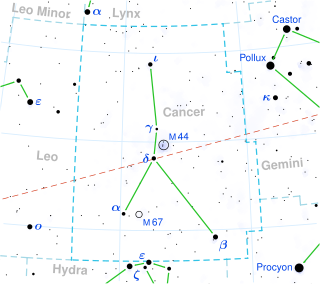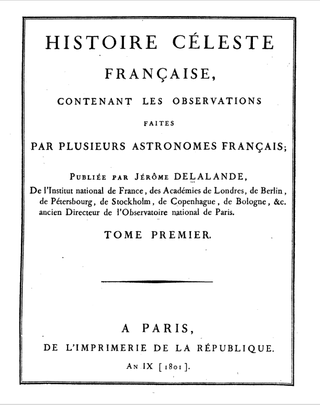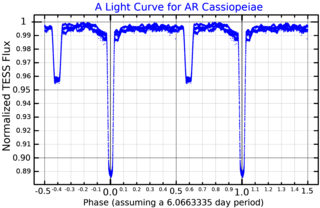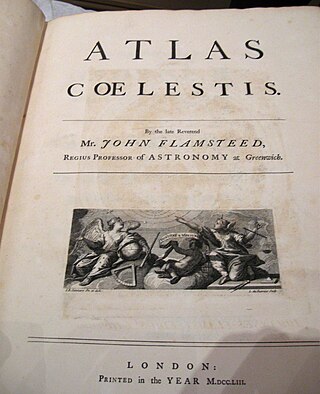
A Bayer designation is a stellar designation in which a specific star is identified by a Greek or Latin letter followed by the genitive form of its parent constellation's Latin name. The original list of Bayer designations contained 1,564 stars. The brighter stars were assigned their first systematic names by the German astronomer Johann Bayer in 1603, in his star atlas Uranometria. Bayer catalogued only a few stars too far south to be seen from Germany, but later astronomers supplemented Bayer's catalog with entries for southern constellations.

Abbé Nicolas-Louis de Lacaille, formerly sometimes spelled de la Caille, was a French astronomer and geodesist who named 14 out of the 88 constellations. From 1750 to 1754, he studied the sky at the Cape of Good Hope in present-day South Africa. Lacaille observed over 10,000 stars using just a half-inch refracting telescope.
In astronomy, stars have a variety of different stellar designations and names, including catalogue designations, current and historical proper names, and foreign language names.

John Flamsteed was an English astronomer and the first Astronomer Royal. His main achievements were the preparation of a 3,000-star catalogue, Catalogus Britannicus, and a star atlas called Atlas Coelestis, both published posthumously. He also made the first recorded observations of Uranus, although he mistakenly catalogued it as a star, and he laid the foundation stone for the Royal Greenwich Observatory.

Epsilon Eridani, proper name Ran, is a star in the southern constellation of Eridanus. At a declination of −9.46°, it is visible from most of Earth's surface. Located at a distance 10.5 light-years from the Sun, it has an apparent magnitude of 3.73, making it the third-closest individual star visible to the naked eye.
The year 1783 in science and technology involved some significant events:

Xi Andromedae, officially named Adhil, is a solitary star in the northern constellation of Andromeda. It has an apparent magnitude of +4.9. Based on parallax measurements obtained during the Gaia mission, it lies at a distance of roughly 223 light-years from the Sun.

13 Cancri is a K-type giant star in the constellation Cancer. It has an apparent magnitude of +6.41 and is approximately 970 light years from Earth.

Omicron1 Canis Majoris is a red supergiant star in the constellation Canis Major. It is also a variable star.
53 Eridani, also designated l Eridani, is a binary star in the constellation of Eridanus. The system has a combined apparent magnitude of 3.87. Parallax estimates made by the Hipparcos spacecraft put it at a distance of about 110 light-years, or 33.7 parsecs, from the Sun.
The Bayer designation Sigma Cancri is shared by three star systems, in the constellation Cancer:

Histoire céleste française is an astrometric star catalogue published in 1801 by the French astronomer Jérôme Lalande and his staff at the Paris Observatory. This star catalog consists of the locations and apparent magnitudes of 47,390 stars, up to magnitude 9. Stars are identified by common name, Bayer designation or Flamsteed designation, when available. It also contains observations of other astronomical phenomena. It was the largest and most complete star catalog of its day. This publication is a collection of several books of astronomical recordings taken over the previous decade at the observatory.
Gould designations for stars are similar to Flamsteed designations in the way that they number stars within a constellation in increasing order of right ascension. Each star is assigned an integer, followed by " G. ", and then the Latin genitive of the constellation it lies in. See 88 modern constellations for a list of constellations and the genitive forms of their names.

AR Cassiopeiae is a variable star in the constellation of Cassiopeia. It is thought to be a member of a septuple star system, one of only two known star systems with a multiplicity of 7, the other being Nu Scorpii.

The Atlas Coelestis is a star atlas published posthumously in 1729, based on observations made by the First Astronomer Royal, John Flamsteed.
56 Ceti is a single star located in the equatorial constellation of Cetus. Not found in the original Bayer catalogue, it was given the Bayer-like designation Upsilon1 Ceti by Flamsteed to distinguish it from Bayer's Upsilon Ceti, which Flamsteed designated Upsilon2 or 59 Ceti. In 1801, J. E. Bode included this designation in his Uranographia, but the superscripted designations Upsilon1 and Upsilon2 are not in general use today. 56 Ceti is the Flamsteed designation for this star.

9 Pegasi is a supergiant star in the constellation Pegasus. Its apparent magnitude is 4.35.

68 Cygni is the Flamsteed designation for a star in the constellation Cygnus. Located approximately 1,400 parsecs (4,600 ly) distant, the star is a hot blue giant of spectral type O7.5IIIn( ), a massive star that is likely currently expanding to become a supergiant. The star is surrounded by a ring-shaped nebula named S 119.
This table lists those stars/objects which have Flamsteed designations by the constellation in which those stars/objects lie. The name given is that of the article if it does not reflect the Flamsteed designation. Some articles are linked twice, in cases where the star has been assigned two different Flamsteed designations, usually as noted in different constellations.













